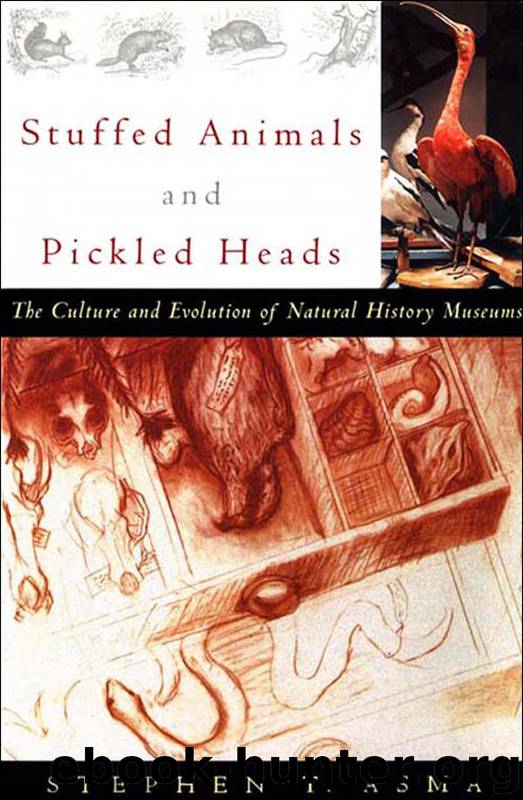Stuffed Animals and Pickled Heads by Asma Stephen T

Author:Asma, Stephen T.
Language: eng
Format: epub
Publisher: Oxford University Press, USA
Published: 2001-03-10T16:00:00+00:00
I wandered a bit more through Cuvier’s collection and eventually found Heidi staring at a shockingly bright orange-and-red orangutan specimen. The glass case was part of the “Respiratory” series, and the orang was splayed out at the bottom of the case. Since it was only the respiratory system that was being exhibited, the animal’s lower half had been removed. This method of truncating specimens to fit them into the limited exhibit spaces is very prevalent in smaller museums, such as those of Hunter and Cuvier. There is something unnerving about these amputated organisms, particularly here at Cuvier’s gallery, where the dissecting prowess does not match Hunter’s clean artistry. Something of the violence of the saws and blades is faintly suggested by the raggedy ends of specimens, a violence that is mercifully absent in Hunter’s meticulous preps. Perhaps, in a more subtle and insidious way, Hunter’s wet preps are creepier because of their seemingly inorganic, highly manicured quality.
Heidi and I left the museum, emerging out of the catacomblike darkness into the brilliant light and color of the gardens. Making our way on the wide gravel paths, we leisurely passed by lavish displays of dahlias and geraniums, a gorgeous rose garden, hundreds of varieties of irises, and then earthenware pots of medicinal herbs. We came across a jaw-droppingly massive cedar tree. A plaque explained that it is one of the oldest trees in Paris, planted by Bernard de Jussieu (the fellow who detected Linnaeus amongst his botany students) in 1734. Here was a living link to the days when Buffon walked these paths. Linnaeus, Buffon, Cuvier, Lamarck, Geoffroy—all of them orbited around this tree, literally and figuratively. The cedar, not just a symbol but an actual expression of nature itself, grew quietly, inexorably onward, while the human mind chronologically circled it for answers. We paused reverentially before this arboreal bridge to the past.
After eating at an outdoor cafe on the west side of the Jardin, we decided to do a museological exploration of the nearby Grande Galerie de l’évolution. As we approached the Grande Galerie I reflected on the taxonomy issues again. Naturalists such as Hunter and Cuvier steered biology away from the Linnean focus on form and toward a new focus on function. But eventually there were nagging problems with this functional way of carving up the categories. Many animal-body plans seemed obviously similar, but these animals did not have similar functions—they did not live in similar environments, they did not eat similar food, they did not behave similarly, and so on. Homologies, such as the jigsaw skulls of mammals and birds that we saw in chapter 1, made no sense from the strictly functional perspective (certainly mammals have to squeeze big heads through small openings during birth, but birds don’t). Cuvier’s colleague at the National Museum, Geoffroy, was increasingly impressed with these nonfunctional homologies of the animal kingdom and wanted to display animals accordingly. Geoffroy even went so far as to promote the idea that mollusks and humans have homologous
Download
This site does not store any files on its server. We only index and link to content provided by other sites. Please contact the content providers to delete copyright contents if any and email us, we'll remove relevant links or contents immediately.
The Lonely City by Olivia Laing(4772)
Animal Frequency by Melissa Alvarez(4430)
All Creatures Great and Small by James Herriot(4273)
Walking by Henry David Thoreau(3926)
Exit West by Mohsin Hamid(3796)
Origin Story: A Big History of Everything by David Christian(3666)
COSMOS by Carl Sagan(3592)
How to Read Water: Clues and Patterns from Puddles to the Sea (Natural Navigation) by Tristan Gooley(3434)
Hedgerow by John Wright(3319)
How to Read Nature by Tristan Gooley(3294)
The Inner Life of Animals by Peter Wohlleben(3286)
How to Do Nothing by Jenny Odell(3265)
Project Animal Farm: An Accidental Journey into the Secret World of Farming and the Truth About Our Food by Sonia Faruqi(3191)
Origin Story by David Christian(3170)
Water by Ian Miller(3157)
A Forest Journey by John Perlin(3044)
The Plant Messiah by Carlos Magdalena(2900)
A Wilder Time by William E. Glassley(2837)
Forests: A Very Short Introduction by Jaboury Ghazoul(2815)
